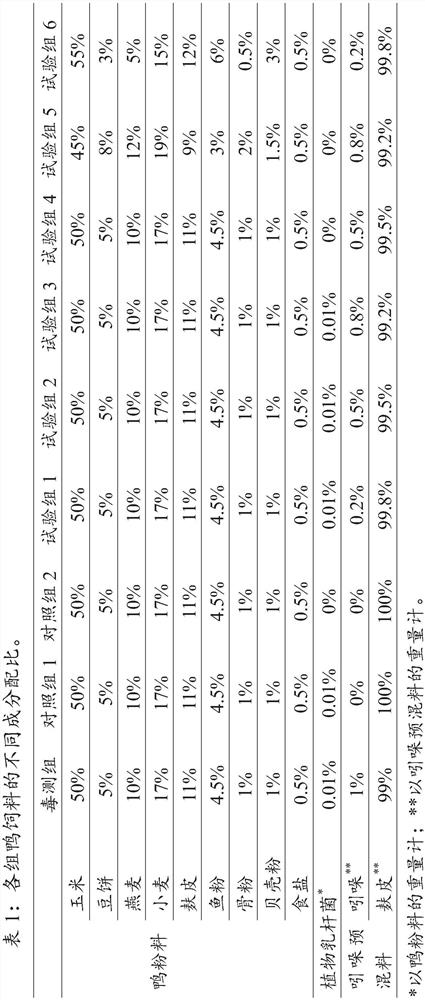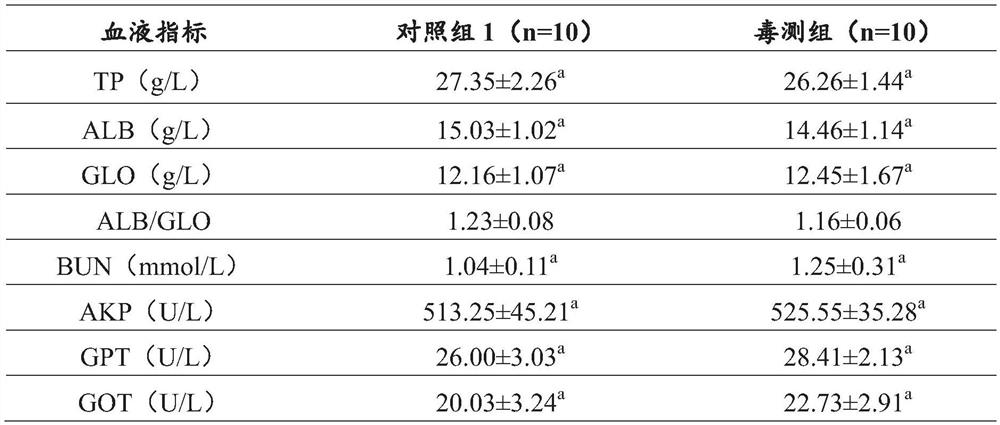Application of indole and duck feed containing indole in maintaining duck intestinal health and/or preventing duck necrotic enteritis
A technology for necrotic enteritis and intestinal health, applied in the field of prevention of duck necrotic enteritis, to achieve the effect of reducing the use of antibiotics and avoiding antibiotic residues
- Summary
- Abstract
- Description
- Claims
- Application Information
AI Technical Summary
Problems solved by technology
Method used
Image
Examples
Embodiment 1
[0049] Embodiment 1: the preparation of duck feed
[0050] Formulate duck feed through the following steps:
[0051] S1: Break food-grade indole with a microcomputer, and sieve with a 40-mesh woven sieve to obtain indole with a particle size of less than 0.425mm;
[0052] S2: Remove the indole obtained by the S1 step treatment in the weight of the indole premix given in Table 1 respectively, and mix it with the bran of the corresponding weight ratio to obtain indole with different indole content Indole premix;
[0053] S3: Pulverize and uniformly mix the ingredients given in the following table 1 in terms of the weight of the duck powder, thereby obtaining self-prepared duck powder; optionally, according to the data given in the following table 1, In addition, add lactobacillus plantarum based on the weight of duck powder;
[0054] S4: Take 50g of each indole premix obtained in the S2 step and 950g of the respective duck powders obtained in the S3 step, add and mix step by ...
Embodiment 2
[0056] Embodiment 2: the toxicity test of indole to duck
[0057] Toxicity test was carried out on 20 22-day-old Gaoyou ducks (10 males and 10 females) to observe whether indole is toxic to ducks. Specifically, raise Gaoyou ducks (5 males and females in each group) with the feed (not containing indole) of the control group 1 prepared in Example 1 and the feed of the toxicity test group (the weight percentage of indole is 0.05%), and continuously Raising for 7 days. After 7 days, three male ducks and three female ducks in the control group and poison test group were randomly dissected.
[0058] It was found by visual inspection that the internal organs obtained from the poison test group did not change compared with the control group. At the same time, the blood biochemical indicators of the control group and the toxicity test group were also detected, and the results are shown in Table 2 below. The results showed that there was no significant difference between the data of ...
Embodiment 3
[0062] Example 3: Intestinal health promotion test of indole
[0063] The experiment adopts single factor design, and the only variable is the content of indole in duck feed.
[0064] Specifically, 280 18-day-old Gaoyou ducks with similar body weight were randomly selected and divided into 4 groups, half male and half female.
[0065] The pre-feeding period was 4 days, and the feed was the feed of the control group 1 in Table 1 in Example 1, that is, no indole; the test period was 28 days, starting from the age of 22 days to the end of the age of 49 days. During the whole test period, all ducks had free access to powder and drinking water, and the diet and feeding management were in accordance with the local standard of Gaoyou Duck Feeding Technical Regulations (DB32 / T910-2006). The daily feed intake of ducks is usually 90g to 100g.
[0066] The test is divided into control group 1, test group 1, test group 2 and test group 3, and the ingredients of the feed are shown in the...
PUM
| Property | Measurement | Unit |
|---|---|---|
| particle size | aaaaa | aaaaa |
| particle size | aaaaa | aaaaa |
| particle size | aaaaa | aaaaa |
Abstract
Description
Claims
Application Information
 Login to View More
Login to View More - R&D
- Intellectual Property
- Life Sciences
- Materials
- Tech Scout
- Unparalleled Data Quality
- Higher Quality Content
- 60% Fewer Hallucinations
Browse by: Latest US Patents, China's latest patents, Technical Efficacy Thesaurus, Application Domain, Technology Topic, Popular Technical Reports.
© 2025 PatSnap. All rights reserved.Legal|Privacy policy|Modern Slavery Act Transparency Statement|Sitemap|About US| Contact US: help@patsnap.com



